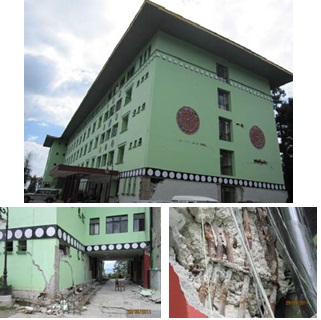NICEE Remembers the 2011 Sikkim Earthquake
on its 10th Anniversary
Today is the 10th anniversary of the deadly Sikkim earthquake of magnitude 6.9 that hit on 18 September 2011 at 6:11 pm IST. Tremors that lasted for about 30�40 sec caused about 100 deaths with a maximum of at least 60 in the worst-affected North District of Sikkim.
The towns of Chungthang and Lachung in the North District suffered maximum damage caused by landslides and poor construction of buildings combined with intense shaking (MMI VIII). The intensity of shaking was VI in and around the state capital, Gangtok, which was also affected significantly. Several structures in Gangtok and adjoining areas that suffered damage in a smaller event of 2006 (14 February 2006; 5.7 Magnitude), and considered vulnerable, suffered severe damage or even collapse during 2011 shaking. Many dramatic collapses and damages were disproportionate to the observed intensity of shaking and can be attributed to poor construction material, deficient workmanship, and lack of compliance with seismic codes and earthquake-resistant construction practices.
Many private and governmental buildings were constructed neglecting the seismic design and detailing requirements necessary in the Zone IV of the Indian seismic code. Many well-built modern buildings, as well as traditional construction prevalent in the area, performed rather satisfactorily due to their inherent earthquake-resistant features and regular maintenance. The geomorphology of Sikkim is prone to landslides which was again evident by the numerous landslides and rockfalls during this earthquake. The ground slope failure resulted in collapses of several reinforced concrete as well as traditional buildings reminding the scientific community about the urgent need of improving the construction practice in sloping terrain.
The traditionally constructed old monastery temple structures of distinctive construction in stone masonry and timber suffered varying degrees of damage to masonry walls ranging from minor damages to partial collapse. Some of the old masonry structures, which were retrofitted after suffering damage in the 1988 Bihar-Nepal earthquake and which withstood the 2006 shaking without any damage, performed satisfactorily during the 2011 earthquake as well signifying the importance of timely retrofitting of structures.
Sikkim is prone to much greater shaking than what was witnessed a decade ago and its aftermath underscores the need for the community to take proactive steps in identifying seismic vulnerabilities and improving construction practices through effective intervention. Very little has changed in Sikkim during the last decade as far as the construction practice is concerned. Seismic risk reduction requires strict adherence to BIS codes for new constructions and for seismic evaluation and strengthening of existing buildings as it is a proven and effective way to achieve seismic resilience in this part of the Himalayan region as well.
Pls visit the following pages at NICEE�s website for more information:
-
Slide show recalling the aftermath of the Sikkim Earthquake:
https://www.nicee.org/Sikkim_Earthquake -
Report on the Sikkim Earthquake:
https://www.nicee.org/Sikkim2011.php -
Earthquake Tips:
https://www.nicee.org/EQTips.php -
Model building codes:
https://www.nicee.org/IITK-GSDMA_Codes.php -
Earthquake Engineering Education:
https://www.nicee.org/npeee -
Confined Masonry Construction:
https://www.nicee.org/confinedmasonry.php
Durgesh C Rai
Coordinator,
National Information Center of Earthquake Engineering (NICEE)
IIT Kanpur
